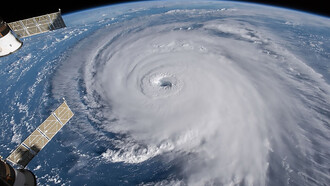What happens when you get pulled into a black hole? For years, this question has stumped scientists, but a recent theory says that when you get pulled into a black hole, another universe sits waiting for you on the other side. This theory has been proven through calculations and was double checked by facts that we already knew about black holes. Scientists also used general relativity to prove their calculations. There are many variations and theories, but the baseline is the universe on the other side. Black holes are thought to be like tunnels, passages between universes. Another term which scientists have assigned to these black holes is “wormholes”. Some scientists think that our universe could be inside a black hole too. And the reason for the delay of answers is the fact that we cannot go inside black holes ourselves because if we were to, we would not come out.
The biggest proof of this theory are the calculations made by groups of scientific researchers. A National Geographic article talks about this theory and the calculations from the research. The first thing they talk about are gamma rays. Gamma rays are the second biggest explosions in the universe after the Big Bang. Scientists do not know what causes them, but black holes could be the answer. “The matter might be escaping into our universe through supermassive black holes —wormholes— at the hearts of those galaxies…” (Than, 2010, p. 2) While it may seem like there is no proof, there is a way to prove this. Many black holes in the universe rotate, and if the theory is correct and our universe was born inside a similarly revolving black hole, then our universe should have inherited the parent object's rotation. Something else they used to prove this wormhole theory is inflation. Inflation is the rapid growth spurt the universe experienced after the Big Bang. This is important because scientists think this was caused by exotic matter, something that is propelled from gravity instead of attracted to it like normal matter. Based on calculations, this team of scientists believe that this exotic matter was made when the first massive stars collapsed and turned into wormholes. If inflation exists, then wormholes do too, meaning that black holes are in fact wormholes.
The group of scientists also used facts about what we already knew about black holes. They used what Einstein, Flamm and Rosen found out to help them develop a more accurate theory. While reviewing Einstein’s theory for general relativity, in 1916, Ludwig Flamm found out about white holes, a theoretical time reversal of a black hole. “Entrances to both black and white holes could be connected by a space-time conduit”. (Redd, 2017, par. 1) The tunnel between the black hole and the white whole was unknown until then, but they still needed more proof for its existence. In 1935, Einstein and a physicist named Nathan Rosen also used general relativity to elaborate on Ludwig Flamm’s theory. They both did research and agreed on the existence of “bridges'' that connected space. The bridges connected different points in space-time which, according to the theory, created a shortcut that could reduce time travel and distance. The bridges were later called Einstein-Rosen Bridges, otherwise known as wormholes.
The final thing proving that black holes have universes on the other side, is the theory of general relativity. As mentioned before, the theory helped all three scientists find out about wormholes, but how? Wormholes are the solution to Einstein's field equations. When viewing the theory of relativity, the main point is the tug of gravity. Since even light cannot escape black holes, the gravitational tug is different for a black hole. When something goes inside a black hole, it cannot come out because of its gravitational tug. Einstein looked deeply into this as it was not as simple as other pulls of gravity. He found that it was like a vacuum, and like a vacuum, all of it had to come out somewhere. The theory did not exactly get into wormholes, but the theory of this place where everything goes proves the existence of it.
Based on all three of these points, black holes are tunnels between universes. Multiple scientists and groups have calculated, and this solution is the most logical. We still have not found actual wormholes, but we do not need to see them to have scientific proof and theories proving the existence of them. If more people work together to find more evidence, this theory could become a fact. Every piece of evidence flows into the next making a strong theory without any holes in the story. The theory of wormholes has been proven and is spreading as more proof arrives. If we believe in this theory and in the evidence backing it, we could be one step closer to a new universe, and we will have more space to solve more mysteries.
Notes
Than, K. (2010). Every Black Hole Contains Another Universe?. National Geographic. April 12.
Redd, N. T. (2017). What is The Wormhole Theory?. Space.com. October 21.
Redd, N. T. (2017). Einstein's Theory of General Relativity. Space.com. November 7.















